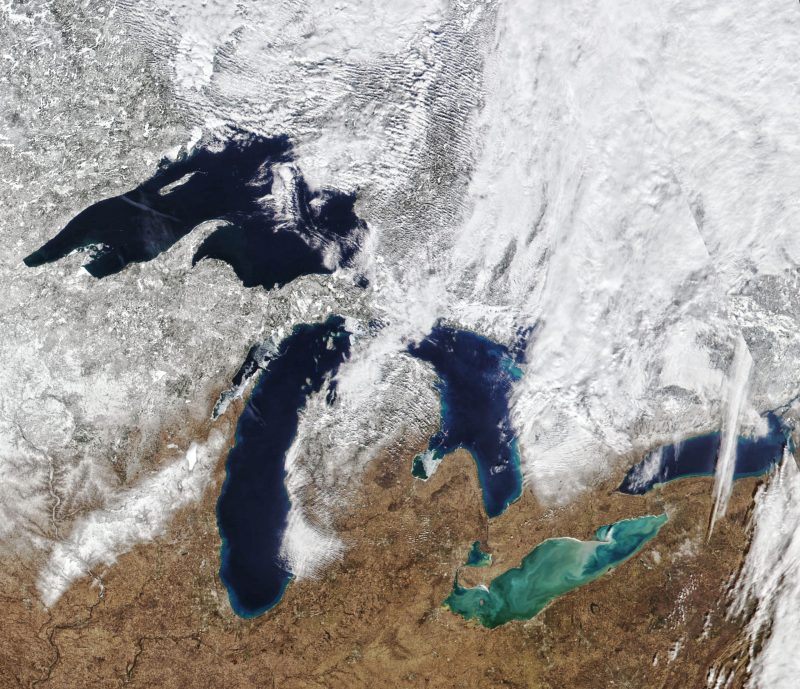
Great Lakes low on ice this winter
There’s more open water in the Great Lakes than usual this winter. As you can see in this satellite image from February 13, 2023, the Great Lakes are largely free of ice cover. NOAA’s Great Lakes Environmental Research Laboratory said that as of mid-February, only 6.6% of the five freshwater lakes are ice-covered. That’s much less than the average of 35 to 40% ice coverage for this time of year.
On the above image from February 13, ice covered 7% of the Great Lakes. That’s the lowest since satellite-based record keeping began in 1973. If you look closely, you can spot ice in Lake Huron’s Saginaw Bay. You can also see ice along the more northerly coastlines. The lighter color of Lake Erie is due to storms kicking up sediments.
Last chance to get a moon phase calendar! Only a few left. On sale now.

Why the low ice cover?
Air temperatures are the culprit in the lack of ice coverage. The U.S. National Ice Center said that warmer-than-average air temperatures affected each of the five lakes in January 2023. In fact, the average temperature across the contiguous United States was 35.2 F (1.7 C). That’s 5.1 degrees F (2.8 C) above average. NOAA said January 2023 was the 6th-warmest January on record.
Cold weather could still bring more ice to the Great Lakes this season. In early February, the ice cover on the Great Lakes was briefly at 21% after a cold spell. But recent warm weather has brought a return of open water. The maximum ice cover for the Great Lakes is normally between mid-February and early March.
A downward trend
Jia Wang, an ice climatologist for NOAA, said that ice coverage has been trending downward over the past 44 years. The official winter period runs from December 1 to April 30. He said that average ice cover on the Great Lakes declined 69% between 1973 and 2017.
While anthropogenic warming is part of the reason for the decline in ice, Wang found a larger factor. Wang said the natural patterns of climate variability over the Pacific and Atlantic oceans are largely responsible. Those patterns include the North Atlantic Oscillation, the Atlantic Multidecadal Oscillation, the Pacific Decadal Oscillation, and the El Niño-Southern Oscillation. Wang said:
Each year we have to look at these four patterns to model ice cover. Right now, the Pacific Decadal Oscillation together with the North Atlantic Oscillation are causing warming in the Great Lakes.
Bottom line: Ice cover is particularly low on the Great Lakes so far this winter. As of mid-February, only 6.6% of the lakes were covered in ice.
Read more: North America’s Great Lakes are losing ice
The post Great Lakes are low on ice cover this winter first appeared on EarthSky.
from EarthSky https://ift.tt/qJ1Dz0I

Great Lakes low on ice this winter
There’s more open water in the Great Lakes than usual this winter. As you can see in this satellite image from February 13, 2023, the Great Lakes are largely free of ice cover. NOAA’s Great Lakes Environmental Research Laboratory said that as of mid-February, only 6.6% of the five freshwater lakes are ice-covered. That’s much less than the average of 35 to 40% ice coverage for this time of year.
On the above image from February 13, ice covered 7% of the Great Lakes. That’s the lowest since satellite-based record keeping began in 1973. If you look closely, you can spot ice in Lake Huron’s Saginaw Bay. You can also see ice along the more northerly coastlines. The lighter color of Lake Erie is due to storms kicking up sediments.
Last chance to get a moon phase calendar! Only a few left. On sale now.

Why the low ice cover?
Air temperatures are the culprit in the lack of ice coverage. The U.S. National Ice Center said that warmer-than-average air temperatures affected each of the five lakes in January 2023. In fact, the average temperature across the contiguous United States was 35.2 F (1.7 C). That’s 5.1 degrees F (2.8 C) above average. NOAA said January 2023 was the 6th-warmest January on record.
Cold weather could still bring more ice to the Great Lakes this season. In early February, the ice cover on the Great Lakes was briefly at 21% after a cold spell. But recent warm weather has brought a return of open water. The maximum ice cover for the Great Lakes is normally between mid-February and early March.
A downward trend
Jia Wang, an ice climatologist for NOAA, said that ice coverage has been trending downward over the past 44 years. The official winter period runs from December 1 to April 30. He said that average ice cover on the Great Lakes declined 69% between 1973 and 2017.
While anthropogenic warming is part of the reason for the decline in ice, Wang found a larger factor. Wang said the natural patterns of climate variability over the Pacific and Atlantic oceans are largely responsible. Those patterns include the North Atlantic Oscillation, the Atlantic Multidecadal Oscillation, the Pacific Decadal Oscillation, and the El Niño-Southern Oscillation. Wang said:
Each year we have to look at these four patterns to model ice cover. Right now, the Pacific Decadal Oscillation together with the North Atlantic Oscillation are causing warming in the Great Lakes.
Bottom line: Ice cover is particularly low on the Great Lakes so far this winter. As of mid-February, only 6.6% of the lakes were covered in ice.
Read more: North America’s Great Lakes are losing ice
The post Great Lakes are low on ice cover this winter first appeared on EarthSky.
from EarthSky https://ift.tt/qJ1Dz0I

Aucun commentaire:
Enregistrer un commentaire